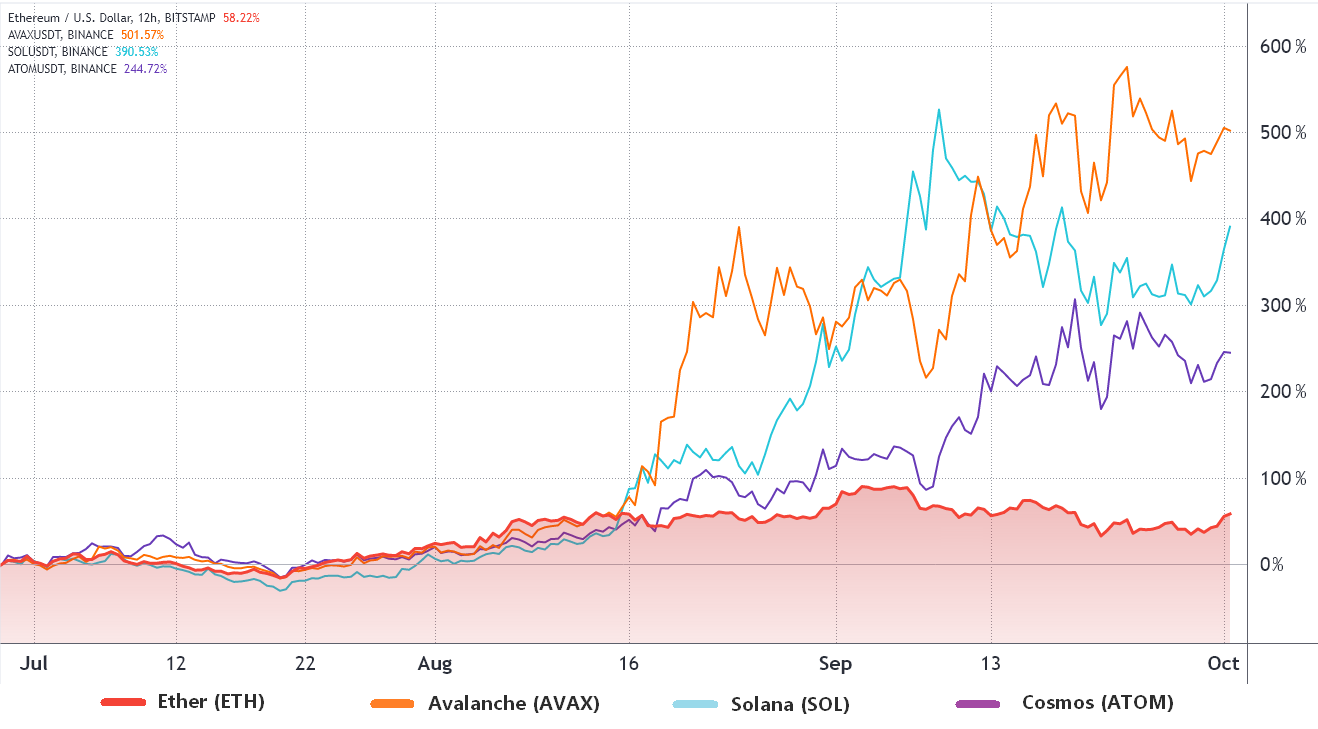On Oct. 1, the cryptocurrency market experienced a 9.5% pump that drove Bitcoin (BTC) and Ether (ETH) to their highest levels in 12 days. A variety of reasons have been attributed to the price move, including the U.S. consumer price index, exchanges’ diminishing supply, and a “cup and handle” bullish continuation chart formation.
Traders are not likely to find an explanation for the sudden move, apart from investors regaining confidence after the Sept. 19 drop was attributed to contagion fears from China-based property developer Evergrande.
The Ethereum network has been facing some criticism due to the $20 or higher transaction costs caused by the nonfungible token (NFT) sales and decentralized finance (DeFi) activity. Cross-chain bridges connecting Ethereum to proof-of-stake (PoS) networks have been partially solving this issue, and Friday’s Umbrella network oracle service launch shows just how fast interoperability is advancing.
It is also worth noting that China’s announced even stricter rules last week had a positive impact on the volumes seen at Decentralized exchanges (DEX). Centralized crypto exchanges, including Huobi and Binance, announced service suspension for Chinese residents, and a significant outflow of coins followed this. At the same time, this increased movement on Uniswap and the decentralized derivatives exchange dYdX.
Even with all this volatility, there are still reasons for investors’ year-end bullishness on Ether. At the same time, the limitations imposed by Ethereum layer-1 scaling also caused some of its competitors to present significant gains over the past couple of months.
 ETH price vs. AVAX, SOL, ATOM. Source: TradingView
ETH price vs. AVAX, SOL, ATOM. Source: TradingView
Notice how Ether’s 58% positive performance in three months has been significantly below those emerging Proof-of-Stake (PoS) solutions offering smart contract capabilities and interoperability.
For bullish traders who think Ether price will break to the upside but are unwilling to face the liquidation risks imposed by futures contracts, the “long condor with call options” strategy might yield more optimal results.
Let’s take a closer look at the strategy.
Options are a safer bet for avoiding liquidations
Options markets provide more flexibility to develop custom strategies and there are two instruments available. The call option gives the buyer upside price protection, and the protective put option does the opposite. Traders can also sell the derivatives to create unlimited negative exposure, which is similar to a futures contract.
 Ether options strategy returns. Source: Deribit Position Builder
Ether options strategy returns. Source: Deribit Position Builder
This long condor strategy has been set for the Dec. 31 expiry and uses a slightly bullish range. The same basic structure can also be applied for other periods or price ranges, although the contract quantities might need some adjustment.
Ether was trading at $3,300 when the pricing took place, but a similar result can be achieved starting from any price level.
The first trade requires buying 0.50 contracts of the $3,200 call options to create positive exposure above this price level. Then, to limit gains above $3,840, the trader needs to sell 0.42 ETH call option contracts. To further limit gains above $5,000, another 0.70 call option contracts should be sold.
To complete the strategy, the trader needs upside protection above $5,500 by buying 0.64 call option contracts if Ether price skyrockets.
The 1.65 to 1 risk-reward ratio is moderately bullish
The strategy might sound complicated to execute, but the margin required is only 0.0314 ETH, which is also the max loss. The potential net profit happens if Ether trades between $3,420 (up 3.6%) and $5,390 (up 63.3%).
Traders should remember that it is also possible to close the position ahead of the Dec. 31 expiry if there’s enough liquidity. The max net gain occurs between $3,840 and $5,000 at 0.0513 ETH, which is 65% higher than the potential loss.
With over 90 days until the expiry date, this strategy gives the holder peace of mind because there is no liquidation risk like futures trading.
The views and opinions expressed here are solely those of the author and do not necessarily reflect the views of Cointelegraph. Every investment and trading move involves risk. You should conduct your own research when making a decision.






